Wave Of Love Plant
The genus Anthurium consists of 1500 species of plants having ornamental value including Anthurium plowmanii which is commonly known as wave of love plant.

Wave of love plant is an ornamental plant with long green leaves having slightly rippled or wavy edges. It has thick, broad bumpy leaves with a shiny green color. The plant generally grows in tropical or subtropical areas. It also performs well in warm temperate regions. It is an epiphytic plant meaning you can grow it on Trees. Besides, It grows well in soil and rocks also. The size of the plant is 1 meter tall and 0.70 meter wide.
The plant isn’t edible and sometimes it shows toxic effects when consumed. Therefore, Children and Pets should be kept away from it.
This plant is also known by several other names such as:- Painted tongue plant, Flamingo flower, Tail flower, Bird’s nest Anthurium etc.
Botanical Classification
| Kingdom | Plantae |
| Family | Araceae |
| Genus | Anthurium |
| Species | Plowmanii |
Origin
Wave of love plant are native to South America especially Brazil, Bolivia, Peru, and Paraguay.
Distribution
The plant is distributed in different regions of tropical and subtropical climate. Though, Originally it was only found in the wild, Now – Many gardeners like me are growing it as an indoor plant. With time many developed and hybrid varieties are produced which are perfect for any gardeners. Currently, It is distributed from the Terra firme habitats Brazil, Dry forest life zones Peru, Bolivia, Philippines.
Characteristics
• Leaves
Wave of love plant is known for its foliage beauty. Leaves of this plant are erect to spreading laterally in rosette fashion, U to C shaped with blunt/wave-like margin and are dark green in color. Leaves are large with green colour, sometimes variegated with yellow. There is a geniculum (a bump) in the joining point of the petiole and leaf blade. Generally, The postharvest life of foliage is of prime importance for commercial cultivation. The recently matured, fully expanded and undamaged leaf showed the longest post harvest life. Leaves are of very large size that can reach up to 2 m in the wild. Don’t Worry, The leaves grow in controlled manner while growing in homes reaching (30-60) cm only.
• Flowers
The plant produces perfect flowers having both male and female reproductive parts. Despite having both male and female reproductive parts in the same flower, It is cross-pollinated. The reason behind this is, The female flowers become receptive earlier than the formation of pollens in male flowers. Therefore, Insects play a major role in pollination.
Interesting fact about the wave of love plant is, It don’t have distinct flowers. Actually, It is an aroid meaning it contains Spadix and Spathe. The central part of Spadix contains tiny flowers which are covered by modified leaves called Spathe. Spadix may be green or grayish in color and is 41 cm long and 2 cm wide. After pollination, The flowers turn into fruits, Berry which contain (1-2) seeds.
If your plant isn’t producing flowers, you should add Phosphorus and Orchid fertilizer along with good sunlight and irrigation.
Kinds Of Wave Of Love Plant
There are different kinds of Wave of love plant some of which are:- Anthurium Andraeanum, Anthurium Crystallinum, Anthurium Superbum, Anthurium Jenmani, Anthurium Hookeri, Anthurium Gelombang Cinta, Anthurium Keris, Anthurium Corong, dll.
Some other kinds of Wave Of Love Plants are:-
Compact Type
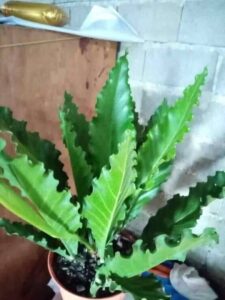
Spreading Type
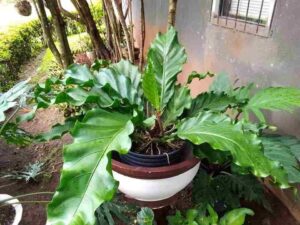
Variegated Type
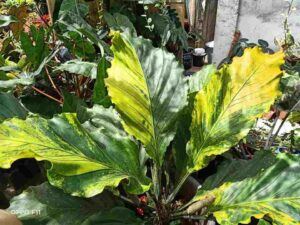
Growing Methods/Propagation
Wave of love plants can be easily propagated using seeds and crowns. Best time to plant in March. We can propagate the plant from following ways:-
• From Plantlets
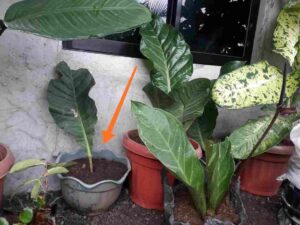
Anthurium produces small stems with leaves which are directly attached to roots. These are like a single plant which can be separated and grown as a new plant. This method is similar to growing an Insulin Plant.
• Root Separation
This is the most successful and commonly followed method of propagating the Wave of love plant. You can just take out plants and separate the roots into many and plant individual rootlets. For an average size plant, (3-4) division of roots can be made. Each division should contain at least one leaf.
• Seed
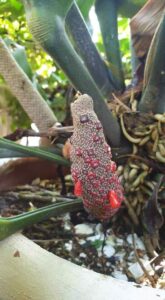
Seed is nature’s way of growing any plant. After pollination, Wave of Love produces berries which contain (1-2) seeds from inside. These seeds can be used to grow new plants.
Care of Wave Of Love Plant
As it is a wild plant which is now domesticated, Much care isn’t needed. People who have less time can also grow it in their home. Though, It isn’t difficult to grow, There are some little things to care which are explained below:-
Soil
Wave of love plant is hardy and shows invasive growth. So, Any substrate is suitable for the growth of this plant. This plant can be grown in a wide range of soil. Soilless culture of this plant is also popular by growing it on wooden logs and even in rocks. If you wish to grow this planet on Pot, then – Proper soil mix should be made. You can add Garden Soil, FYM, and Vermicompost in equal amounts. Perlite can also be added to increase in water holding capacity.
Light
The plants require at least four hours of daily sunlight. It prefers bright
Sunlight but full sun is harmful. Intense sunlight for long time may cause leaf scorching or misshapen leaf.
Temperature
Wave of love plant prefers a very warm temperature of (70-90)°C as it is native to Tropical region. However, the growth stops when temperature drops below 50°C. Therefore, In cold regions and winter season, The plant should be kept indoors.
Water
This plant prefers moist soil but soggy soil is harmful. So, proper care should be done for water management. Watering should be done when the first inch of soil becomes dry in touching and watering should be stopped when water starts draining from the drainage holes. Overwatering should be avoided as the roots of this plant are susceptible to rot. The droopy and puckering leaves are the signs of water stress in the Anthurium plant. There is no need to worry much about watering as it is hardy and fairly drought tolerant.
Humidity
Wave of love plant prefers a humid environment as in a tropical rainforest. However, flowering varieties can withstand extreme dry weather. Humidity of 60% should be maintained.
Fertilizer
It isn’t a heavy feeder. Slow releasing fertilizer along with a good amount of phosphorus can be given every 20 days during summer. Fertilizer shouldn’t be given during winter season/Dormant season. You can also add FYM, Vermicompost and Cocopeat while making soil mix which works as a fertilizer.
Potting and Repotting
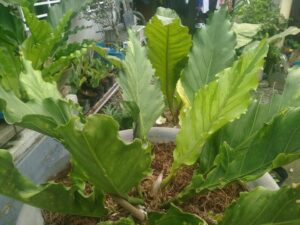
Despite being a large plant, It can grow in a relatively small pot. However, When the plant reaches a round-bound condition or if you start to see roots coming out from the drainage hole of the pot, Then – Understand it is the time of Repotting (Which usually occurs in about 1.5 years). Repotting should be done in the evening. For Repotting, You just simply take the plant from the pot. The roots contain earth balls. Remove all the soil from roots and cut some roots. Now, Take a pot larger than earlier, Fill it with pot mix and repot the Plant. Water it and keep it in partial shade. After a few days, You can place it whenever you want.
Benefits
The plant itself is a gift from mother nature. It is loved by many people from all around the world. Some of the benefits of wave of love plant are:-
• It provides aesthetic pleasure. It is grown indoors for decoration.
• This plant purifys indoor air by producing more oxygen. So – Keeping it on our room will keep us fresh and cool
• It is used to give as a gift as it symbolises long lasting friendship.
• This plant has high market value. So, It also has commercial importance.
Bottom Line
Wave of love plant is a fantastic indoor plant. You can grow it easily if you have decent space. Placing it on tables and windows will make the house aesthetically beautiful.
You May Like These Articles:-
Narra Tree: Characteristics, Botany, Uses And Harvesting
